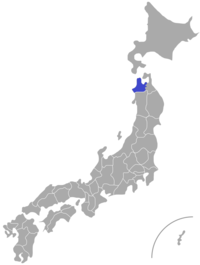| Tsugaru dialect | |
|---|---|
| Aomori dialect | |
 Tsugaru dialect area. Tsugaru dialect area. | |
| Native to | Japan |
| Region | Aomori |
| Language family | Japonic
|
| Language codes | |
| ISO 639-3 | – |
| Glottolog | tsug1237 |
| IETF | ja-u-sd-jp02 |
The Tsugaru dialect (津軽弁, Tsugaru-ben) is a Japanese dialect spoken in western Aomori Prefecture.
The Tsugaru dialect is reputed to be so divergent from standard Japanese for those who are not native speakers, that even people living in the same prefecture may have trouble understanding it. In 1988, fans of the Tsugaru dialect proclaimed October 23 to be Tsugaru Dialect Day (津軽弁の日, Tsugaru-ben no hi). October 23 is the anniversary of the death of Takagi Kyozo, a famous poet who wrote in the Tsugaru dialect.
In Tsuruta, there is an annual summer Tsugaru-ben competition (津軽弁大会, Tsugaru-ben taikai) in which teams of foreigners create short skits or performances, usually humorous, using the dialect. In June 2009, a short segment featuring the competition was broadcast nationally on NHK.
Examples
The words are sometimes very different from those of standard Japanese.
| English | Standard Japanese | Tsugaru dialect |
|---|---|---|
| I | 私 (わたし, watashi) | わ (wa) |
| you | あなた (anata) | な (na) |
| cute | かわいい (kawaii) | めごい (megoi) |
| friend | 友達 (ともだち, tomodachi) | けやぐ (keyagu) |
| countryside | 田舎 (いなか, inaka) | じゃご (jyago) |
| but | けれど (keredo) | だばって (dabatte) |
| same | 同じ (おなじ, onaji) | ふとず (futozu) |
| very | とても (totemo) | たげ/がっぱ (tage/gappa) |
| cold | 冷たい (つめたい, tsumetai) | しゃっこい (shakkoi) |
| warm | 暖かい (あたたかい, atatakai) | ぬげ (nuge) |
| noisy | うるさい (urusai) | さしね (sashine) |
| irritating | イライラする (ira-irasuru) | かちゃくちゃね (kacha-kuchane) |
| money | (お)金 ((お)かね, (o-)kane) | じぇんこ (jenko) |
| forehead | ひたい (hitai), (お)でこ ((o-)deko) | なずぎ (nazugi) |
| home | 家 (いえ, ie) | え (e) |
| cooked rice/meal | ごはん (gohan) | まま (mama) |
| to freeze (transitive verb) | 凍らせる (こおらせる, kooraseru) | しみらがす (shimiragasu) |
| to freeze (intransitive verb) | 凍る (こおる, kooru) | しみる (shimiru) |
| to eat (verb) | 食べる (たべる, taberu), 食う (くう, kuu) (colloquial) | く (ku) |
Notes
- The ResearchGate mirror (archive) contains metadata about the presentation.
References
- Takubo, Yukinori (2018-08-08). Mutual Intelligibility as a measure of linguistic distance and intergenerational transmission (PDF). Approaches to Endangered Languages in Japan and Northeast Asia: Description, Documentation and Revitalization. National Institute for Japanese Language and Linguistics. pp. 16 and 29. doi:10.13140/RG.2.2.12014.66880. Archived from the original (PDF) on 2022-12-24 – via ResearchGate.
External links
- (in Japanese) Tsugaru-ben dictionary
- (in Japanese) Suzumeko (Aozora Bunko) - a Tsugaru-ben short novel by Osamu Dazai
- A reading of Tsugaru-ben poem in Tsugaru Dialect Day 2008 on YouTube
- A reading of Tsugaru-ben poem in Tsugaru Dialect Day 2008 on YouTube
- Talking about food in Tsugaru-ben on YouTube
- Talk of locals in Kanita Station, Aomori on YouTube
| Japanese language | |||||||||
|---|---|---|---|---|---|---|---|---|---|
| Earlier forms | |||||||||
| Dialects |
| ||||||||
| Pidgins and creoles | |||||||||
| Japonic languages |
| ||||||||
| Writing system |
| ||||||||
| Grammar and vocabulary |
| ||||||||
| Phonology |
| ||||||||
| Transliteration | |||||||||
| Literature | |||||||||
This article about a Japonic language or related topic is a stub. You can help Misplaced Pages by expanding it. |